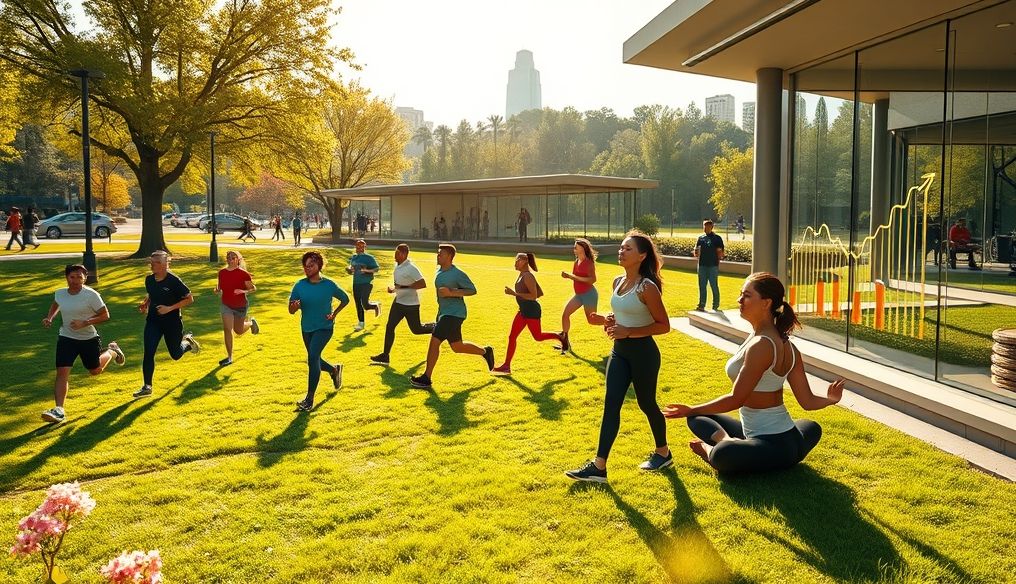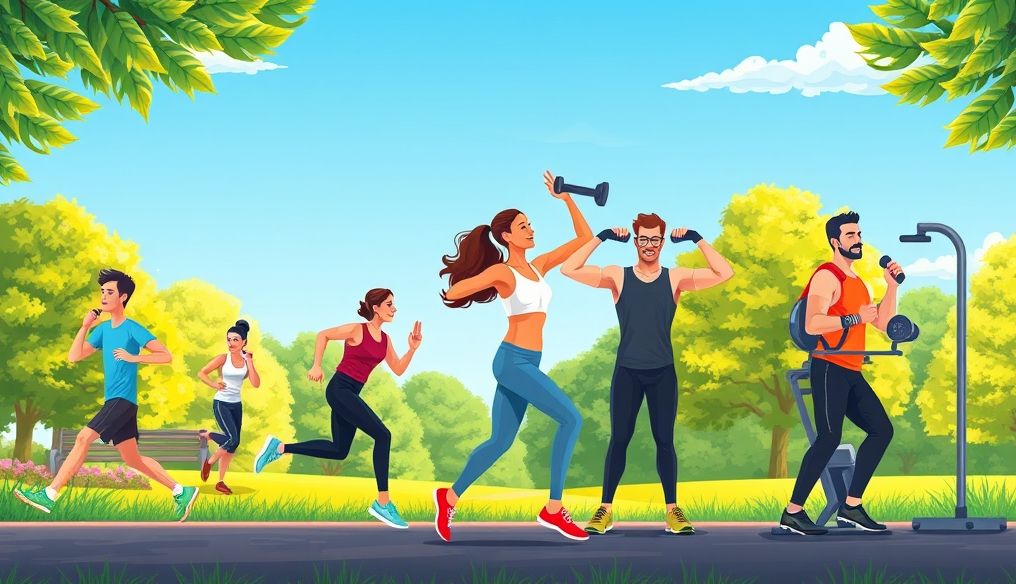What is the Relationship Between Physical Exercise and Mental Fitness?
We've always known that physical exercise is good for our bodies, but did you know that it also plays a crucial role in the health of our minds? The relationship between physical exercise and mental fitness is deeper and more complex than you might imagine. This article explores this relationship in detail, providing you with scientific evidence and practical tips to improve your mental health through physical activity.
Chapter 1: How Does Physical Exercise Affect the Brain?
The physiological effects of physical exercise on the brain are multifaceted. Here are some of the main ways exercise benefits your mind:
1. Enhancing Blood Flow to the Brain
During exercise, your heart rate and blood flow increase. This means that more oxygen and nutrients reach the brain, improving its overall function. This increased blood flow supports:
- Improved memory and concentration
- Reduced risk of stroke
- Promotion of new brain cell growth (neurogenesis)
2. Releasing Neurotransmitters
Physical exercise stimulates the release of neurotransmitters such as:
- Serotonin: Helps regulate mood and reduce depression and anxiety.
- Dopamine: Associated with feelings of happiness and motivation, and improves focus and attention.
- Norepinephrine: Enhances alertness and attention, and helps manage stress.
- Endorphins: Natural pain relievers and mood enhancers, reduce stress and create a sense of well-being.
These neurotransmitters play a vital role in improving mood, reducing stress, and enhancing cognitive functions.
3. Stimulating New Brain Cell Growth (Neurogenesis)
Research suggests that physical exercise stimulates the growth of new brain cells in the hippocampus, a region important for learning and memory. This means that exercise can help:
- Improve short-term and long-term memory
- Increase the ability to learn and acquire new skills
- Protect the brain from age-related decline
4. Reducing Inflammation
Chronic inflammation in the body and brain can contribute to the development of many neurological and psychological disorders. Physical exercise helps reduce inflammation, protecting the brain and improving its function.
Chapter 2: Mental Health Benefits of Physical Exercise
The mental benefits of physical exercise are wide-ranging and include:
1. Improving Mood and Reducing Depression and Anxiety
Physical exercise is a natural and effective treatment for depression and anxiety. By releasing mood-enhancing neurotransmitters and reducing stress, exercise can help alleviate symptoms and improve overall mood.
2. Enhancing Memory and Concentration
Physical exercise improves blood flow to the brain and stimulates the growth of new brain cells, which enhances memory and concentration. This is especially beneficial for students, seniors, and people with memory or concentration problems.
3. Improving Cognitive Functions
Physical exercise improves a wide range of cognitive functions, including:
- Working memory
- Cognitive flexibility (the ability to adapt to new tasks)
- Processing speed
- Problem-solving
4. Protecting Against Age-Related Cognitive Decline
Research suggests that regular physical exercise can help protect the brain from age-related decline and reduce the risk of developing diseases like Alzheimer's and dementia.
5. Improving Sleep Quality
Regular physical exercise can help improve sleep quality, which positively affects mood and cognitive functions.
Chapter 3: Types of Physical Exercise Most Beneficial for the Mind
Not all types of physical exercise are equal in terms of mental benefits. Some types may be more effective than others. Here are some options:
1. Aerobic Exercise (Cardio)
Includes walking, running, swimming, and cycling. These exercises increase heart rate and blood flow to the brain, improving cognitive functions and mood.
2. Strength Training
Includes weightlifting and bodyweight exercises. These exercises not only build muscle but also improve cognitive functions and mood.
3. Yoga and Meditation
Yoga and meditation combine physical activity with mental relaxation, reducing stress and improving mood and concentration.
4. Tai Chi
An ancient Chinese exercise that combines slow, flowing movements with deep breathing. Tai Chi is beneficial for improving balance, coordination, reducing stress, and improving cognitive functions.
Chapter 4: How to Start an Exercise Program to Improve Your Mental Health
If you want to reap the mental benefits of physical exercise, here are some tips to get started:
1. Consult Your Doctor
Before starting any new exercise program, consult your doctor to make sure it is safe for you.
2. Start Slowly
If you are not used to exercising, start slowly and gradually increase the duration and intensity of your workouts.
3. Choose Activities You Enjoy
You are more likely to stick to an exercise program if you enjoy the activities you do.
4. Set Realistic Goals
Don't try to do too much too soon. Set realistic and achievable goals.
5. Make It a Habit
Try to incorporate physical exercise into your daily routine. Set aside a specific time each day or week to exercise.
Chapter 5: Nutrition and Its Role in Enhancing Mental Fitness with Exercise
Proper nutrition plays a complementary role to physical exercise in enhancing mental fitness. Certain nutrients play a special role in supporting brain function:
1. Omega-3 Fatty Acids
Found in fatty fish (salmon, tuna), flaxseeds, and walnuts. Support brain health and improve memory and mood.
2. Antioxidants
Found in colorful fruits and vegetables. Protect brain cells from damage caused by free radicals.
3. B Vitamins
Found in whole grains, meats, and leafy green vegetables. Essential for nerve function and neurotransmitter production.
4. Water
Staying hydrated is essential for optimal brain function. Dehydration can negatively affect concentration and memory.
Chapter 6: Integrating Physical Exercise into Your Daily Lifestyle
It is not necessary to spend hours in the gym to reap the benefits of physical exercise. There are simple ways to incorporate physical activity into your daily lifestyle:
1. Walking
Walk to work, school, or the store. Use the stairs instead of the elevator.
2. Household Activities
Take care of the garden, clean the house, and do maintenance work yourself.
3. Social Activities
Participate in sports activities with friends and family.
4. Active Breaks
Take short breaks from work or study to do some light exercise or walk around.
Chapter 7: Real-Life Success Stories
There are many inspiring stories of people who have improved their mental health through physical exercise. For example:
- A person suffering from depression started walking daily and felt a significant improvement in their mood and energy.
- A student who had difficulty concentrating started practicing yoga and felt an improvement in their focus and academic performance.
- An elderly person who had memory problems started practicing Tai Chi and felt an improvement in their memory and balance.
Chapter 8: Conclusion and Recommendations
Physical exercise is a powerful tool for improving your mental health. By enhancing blood flow to the brain, releasing beneficial neurotransmitters, stimulating new brain cell growth, and reducing inflammation, physical exercise can improve mood, enhance memory and concentration, and protect against age-related cognitive decline. Start today by incorporating physical exercise into your daily lifestyle and enjoy the mental benefits it offers.
Remember: Mental health is just as important as physical health. Take care of your body and mind together!




